A highly conserved molecular switch binds MSY-3 to regulate myogenin repression in postnatal muscle
- PMID: 18676817
- PMCID: PMC2492748
- DOI: 10.1101/gad.468508
A highly conserved molecular switch binds MSY-3 to regulate myogenin repression in postnatal muscle
Abstract
Myogenin is the dominant transcriptional regulator of embryonic and fetal muscle differentiation and during maturation is profoundly down-regulated. We show that a highly conserved 17-bp DNA cis-acting sequence element located upstream of the myogenin promoter (myogHCE) is essential for postnatal repression of myogenin in transgenic animals. We present multiple lines of evidence supporting the idea that repression is mediated by the Y-box protein MSY-3. Electroporation in vivo shows that myogHCE and MSY-3 are required for postnatal repression. We further show that, in the C2C12 cell culture system, ectopic MSY-3 can repress differentiation, while reduced MSY-3 promotes premature differentiation. MSY-3 binds myogHCE simultaneously with the homeodomain protein Pbx in postnatal innervated muscle. We therefore propose a model in which the myogHCE motif operates as a switch by specifying opposing functions; one that was shown previously is regulated by MyoD and Pbx and it specifies a chromatin opening, gene-activating function at the time myoblasts begin to differentiate; the other includes MYS-3 and Pbx, and it specifies a repression function that operates during and after postnatal muscle maturation in vivo and in myoblasts before they begin to differentiate.
Figures
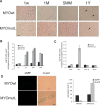

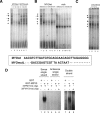
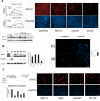
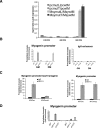
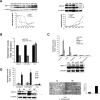

Similar articles
-
Constitutive expression of the orphan receptor, Rev-erbA alpha, inhibits muscle differentiation and abrogates the expression of the myoD gene family.Mol Endocrinol. 1995 Dec;9(12):1666-78. doi: 10.1210/mend.9.12.8614403. Mol Endocrinol. 1995. PMID: 8614403
-
The small chromatin-binding protein p8 coordinates the association of anti-proliferative and pro-myogenic proteins at the myogenin promoter.J Cell Sci. 2009 Oct 1;122(Pt 19):3481-91. doi: 10.1242/jcs.048678. Epub 2009 Sep 1. J Cell Sci. 2009. PMID: 19723804 Free PMC article.
-
Identification of a regulatory function for an orphan receptor in muscle: COUP-TF II affects the expression of the myoD gene family during myogenesis.Nucleic Acids Res. 1995 Apr 25;23(8):1311-8. doi: 10.1093/nar/23.8.1311. Nucleic Acids Res. 1995. PMID: 7753622 Free PMC article.
-
Calcineurin initiates skeletal muscle differentiation by activating MEF2 and MyoD.Differentiation. 2003 Apr;71(3):217-27. doi: 10.1046/j.1432-0436.2003.710303.x. Differentiation. 2003. PMID: 12694204
-
Regulating a master regulator: establishing tissue-specific gene expression in skeletal muscle.Epigenetics. 2010 Nov-Dec;5(8):691-5. doi: 10.4161/epi.5.8.13045. Epub 2010 Nov 1. Epigenetics. 2010. PMID: 20716948 Free PMC article. Review.
Cited by
-
Tissue-specific epigenetics in gene neighborhoods: myogenic transcription factor genes.Hum Mol Genet. 2015 Aug 15;24(16):4660-73. doi: 10.1093/hmg/ddv198. Epub 2015 Jun 3. Hum Mol Genet. 2015. PMID: 26041816 Free PMC article.
-
The genome variation and developmental transcriptome maps reveal genetic differentiation of skeletal muscle in pigs.PLoS Genet. 2021 Nov 15;17(11):e1009910. doi: 10.1371/journal.pgen.1009910. eCollection 2021 Nov. PLoS Genet. 2021. PMID: 34780471 Free PMC article.
-
Dach2-Hdac9 signaling regulates reinnervation of muscle endplates.Development. 2015 Dec 1;142(23):4038-48. doi: 10.1242/dev.125674. Epub 2015 Oct 19. Development. 2015. PMID: 26483211 Free PMC article.
-
Akt-mediated phosphorylation controls the activity of the Y-box protein MSY3 in skeletal muscle.Skelet Muscle. 2015 May 29;5:18. doi: 10.1186/s13395-015-0043-9. eCollection 2015. Skelet Muscle. 2015. PMID: 26146542 Free PMC article.
-
PAK1 and CtBP1 Regulate the Coupling of Neuronal Activity to Muscle Chromatin and Gene Expression.Mol Cell Biol. 2015 Dec;35(24):4110-20. doi: 10.1128/MCB.00354-15. Epub 2015 Sep 28. Mol Cell Biol. 2015. PMID: 26416879 Free PMC article.
References
-
- Berberich C., Durr I., Koenen M., Witzemann V. Two adjacent E box elements and a M-CAT box are involved in the muscle-specific regulation of the rat acetylcholine receptor beta subunit gene. Eur. J. Biochem. 1993;216:395–404. - PubMed
-
- Berkes C.A., Bergstrom D.A., Penn B.H., Seaver K.J., Knoepfler P.S., Tapscott S.J. Pbx marks genes for activation by MyoD indicating a role for a homeodomain protein in establishing myogenic potential. Mol. Cell. 2004;14:465–477. - PubMed
Publication types
MeSH terms
Substances
LinkOut - more resources
Full Text Sources
Molecular Biology Databases
